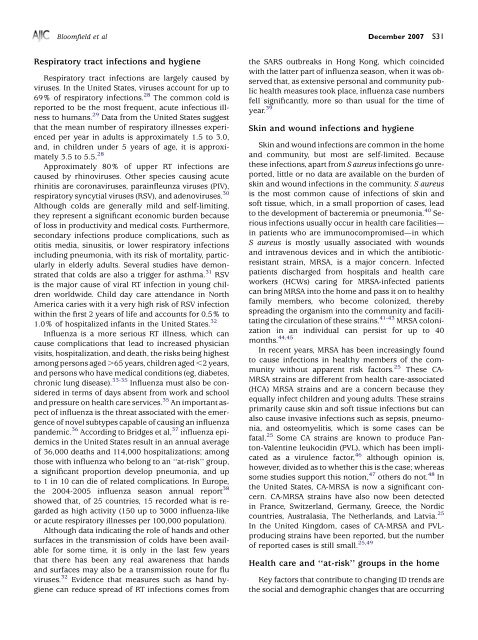The effectiveness of hand hygiene procedures in reducing the risks ...
The effectiveness of hand hygiene procedures in reducing the risks ...
The effectiveness of hand hygiene procedures in reducing the risks ...
Create successful ePaper yourself
Turn your PDF publications into a flip-book with our unique Google optimized e-Paper software.
Bloomfield et al December 2007 S31Respiratory tract <strong>in</strong>fections and <strong>hygiene</strong>Respiratory tract <strong>in</strong>fections are largely caused byviruses. In <strong>the</strong> United States, viruses account for up to69% <strong>of</strong> respiratory <strong>in</strong>fections. 28 <strong>The</strong> common cold isreported to be <strong>the</strong> most frequent, acute <strong>in</strong>fectious illnessto humans. 29 Data from <strong>the</strong> United States suggestthat <strong>the</strong> mean number <strong>of</strong> respiratory illnesses experiencedper year <strong>in</strong> adults is approximately 1.5 to 3.0,and, <strong>in</strong> children under 5 years <strong>of</strong> age, it is approximately3.5 to 5.5. 28Approximately 80% <strong>of</strong> upper RT <strong>in</strong>fections arecaused by rh<strong>in</strong>oviruses. O<strong>the</strong>r species caus<strong>in</strong>g acuterh<strong>in</strong>itis are coronaviruses, para<strong>in</strong>fleunza viruses (PIV),respiratory syncytial viruses (RSV), and adenoviruses. 30Although colds are generally mild and self-limit<strong>in</strong>g,<strong>the</strong>y represent a significant economic burden because<strong>of</strong> loss <strong>in</strong> productivity and medical costs. Fur<strong>the</strong>rmore,secondary <strong>in</strong>fections produce complications, such asotitis media, s<strong>in</strong>usitis, or lower respiratory <strong>in</strong>fections<strong>in</strong>clud<strong>in</strong>g pneumonia, with its risk <strong>of</strong> mortality, particularly<strong>in</strong> elderly adults. Several studies have demonstratedthat colds are also a trigger for asthma. 31 RSVis <strong>the</strong> major cause <strong>of</strong> viral RT <strong>in</strong>fection <strong>in</strong> young childrenworldwide. Child day care attendance <strong>in</strong> NorthAmerica caries with it a very high risk <strong>of</strong> RSV <strong>in</strong>fectionwith<strong>in</strong> <strong>the</strong> first 2 years <strong>of</strong> life and accounts for 0.5% to1.0% <strong>of</strong> hospitalized <strong>in</strong>fants <strong>in</strong> <strong>the</strong> United States. 32Influenza is a more serious RT illness, which cancause complications that lead to <strong>in</strong>creased physicianvisits, hospitalization, and death, <strong>the</strong> <strong>risks</strong> be<strong>in</strong>g highestamong persons aged .65 years, children aged ,2 years,and persons who have medical conditions (eg, diabetes,chronic lung disease). 33-35 Influenza must also be considered<strong>in</strong> terms <strong>of</strong> days absent from work and schooland pressure on health care services. 35 An important aspect<strong>of</strong> <strong>in</strong>fluenza is <strong>the</strong> threat associated with <strong>the</strong> emergence<strong>of</strong> novel subtypes capable <strong>of</strong> caus<strong>in</strong>g an <strong>in</strong>fluenzapandemic. 36 Accord<strong>in</strong>g to Bridges et al, 37 <strong>in</strong>fluenza epidemics<strong>in</strong> <strong>the</strong> United States result <strong>in</strong> an annual average<strong>of</strong> 36,000 deaths and 114,000 hospitalizations; amongthose with <strong>in</strong>fluenza who belong to an ‘‘at-risk’’ group,a significant proportion develop pneumonia, and upto 1 <strong>in</strong> 10 can die <strong>of</strong> related complications. In Europe,<strong>the</strong> 2004-2005 <strong>in</strong>fluenza season annual report 38showed that, <strong>of</strong> 25 countries, 15 recorded what is regardedas high activity (150 up to 3000 <strong>in</strong>fluenza-likeor acute respiratory illnesses per 100,000 population).Although data <strong>in</strong>dicat<strong>in</strong>g <strong>the</strong> role <strong>of</strong> <strong>hand</strong>s and o<strong>the</strong>rsurfaces <strong>in</strong> <strong>the</strong> transmission <strong>of</strong> colds have been availablefor some time, it is only <strong>in</strong> <strong>the</strong> last few yearsthat <strong>the</strong>re has been any real awareness that <strong>hand</strong>sand surfaces may also be a transmission route for fluviruses. 32 Evidence that measures such as <strong>hand</strong> <strong>hygiene</strong>can reduce spread <strong>of</strong> RT <strong>in</strong>fections comes from<strong>the</strong> SARS outbreaks <strong>in</strong> Hong Kong, which co<strong>in</strong>cidedwith <strong>the</strong> latter part <strong>of</strong> <strong>in</strong>fluenza season, when it was observedthat, as extensive personal and community publichealth measures took place, <strong>in</strong>fluenza case numbersfell significantly, more so than usual for <strong>the</strong> time <strong>of</strong>year. 39Sk<strong>in</strong> and wound <strong>in</strong>fections and <strong>hygiene</strong>Sk<strong>in</strong> and wound <strong>in</strong>fections are common <strong>in</strong> <strong>the</strong> homeand community, but most are self-limited. Because<strong>the</strong>se <strong>in</strong>fections, apart from S aureus <strong>in</strong>fections go unreported,little or no data are available on <strong>the</strong> burden <strong>of</strong>sk<strong>in</strong> and wound <strong>in</strong>fections <strong>in</strong> <strong>the</strong> community. S aureusis <strong>the</strong> most common cause <strong>of</strong> <strong>in</strong>fections <strong>of</strong> sk<strong>in</strong> ands<strong>of</strong>t tissue, which, <strong>in</strong> a small proportion <strong>of</strong> cases, leadto <strong>the</strong> development <strong>of</strong> bacteremia or pneumonia. 40 Serious<strong>in</strong>fections usually occur <strong>in</strong> health care facilities—<strong>in</strong> patients who are immunocompromised—<strong>in</strong> whichS aureus is mostly usually associated with woundsand <strong>in</strong>travenous devices and <strong>in</strong> which <strong>the</strong> antibioticresistantstra<strong>in</strong>, MRSA, is a major concern. Infectedpatients discharged from hospitals and health careworkers (HCWs) car<strong>in</strong>g for MRSA-<strong>in</strong>fected patientscan br<strong>in</strong>g MRSA <strong>in</strong>to <strong>the</strong> home and pass it on to healthyfamily members, who become colonized, <strong>the</strong>rebyspread<strong>in</strong>g <strong>the</strong> organism <strong>in</strong>to <strong>the</strong> community and facilitat<strong>in</strong>g<strong>the</strong> circulation <strong>of</strong> <strong>the</strong>se stra<strong>in</strong>s. 41-43 MRSA colonization<strong>in</strong> an <strong>in</strong>dividual can persist for up to 40months. 44,45In recent years, MRSA has been <strong>in</strong>creas<strong>in</strong>gly foundto cause <strong>in</strong>fections <strong>in</strong> healthy members <strong>of</strong> <strong>the</strong> communitywithout apparent risk factors. 25 <strong>The</strong>se CA-MRSA stra<strong>in</strong>s are different from health care-associated(HCA) MRSA stra<strong>in</strong>s and are a concern because <strong>the</strong>yequally <strong>in</strong>fect children and young adults. <strong>The</strong>se stra<strong>in</strong>sprimarily cause sk<strong>in</strong> and s<strong>of</strong>t tissue <strong>in</strong>fections but canalso cause <strong>in</strong>vasive <strong>in</strong>fections such as sepsis, pneumonia,and osteomyelitis, which is some cases can befatal. 25 Some CA stra<strong>in</strong>s are known to produce Panton-Valent<strong>in</strong>eleukocid<strong>in</strong> (PVL), which has been implicatedas a virulence factor, 46 although op<strong>in</strong>ion is,however, divided as to whe<strong>the</strong>r this is <strong>the</strong> case; whereassome studies support this notion, 47 o<strong>the</strong>rs do not. 48 In<strong>the</strong> United States, CA-MRSA is now a significant concern.CA-MRSA stra<strong>in</strong>s have also now been detected<strong>in</strong> France, Switzerland, Germany, Greece, <strong>the</strong> Nordiccountries, Australasia, <strong>The</strong> Ne<strong>the</strong>rlands, and Latvia. 25In <strong>the</strong> United K<strong>in</strong>gdom, cases <strong>of</strong> CA-MRSA and PVLproduc<strong>in</strong>gstra<strong>in</strong>s have been reported, but <strong>the</strong> number<strong>of</strong> reported cases is still small. 25,49Health care and ‘‘at-risk’’ groups <strong>in</strong> <strong>the</strong> homeKey factors that contribute to chang<strong>in</strong>g ID trends are<strong>the</strong> social and demographic changes that are occurr<strong>in</strong>g


